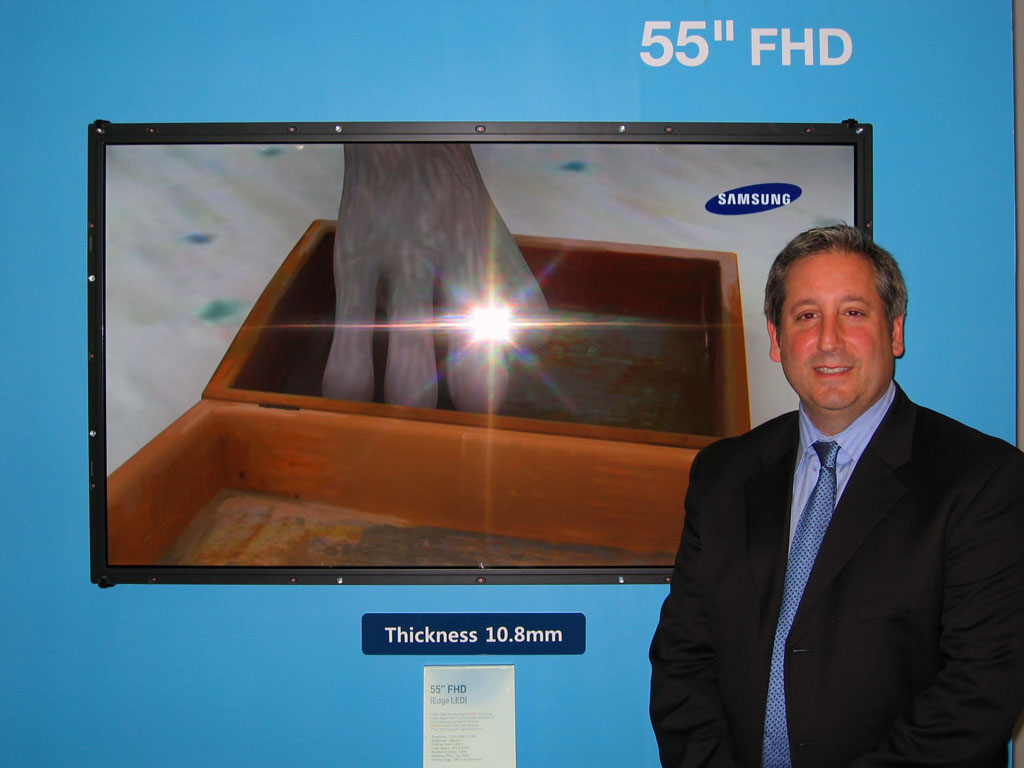CES '09: Morsels From Our Meetings
Samsung's SSDs And LCDs
Samsung Shows Off Storage/Displays
Samsung had a ton of technology to show off at CES; we focused on the storage and display products it was demonstrating.
It was interesting to talk to the company’s hard drive and SSD divisions back to back. Naturally, they’re completely separate divisions, both trying to grow their respective businesses. But it seems clear that solid state technology is the growth opportunity. The hard drive guys were showing off upcoming 1.5 TB EcoGreen drives, which are the slower-spinning 5,400 RPM disks designed to cut back on power consumption. No plans were in place yet to make the jump to 1.5 TB with the 7,200 RPM Spinpoint F1s, though.
Also on display were Samsung’s new external DAS drives based on 2.5” disks. This is a market segment that Samsung recognized it was late in addressing and is now doing so.
On the SSD front, Samsung mentioned that it’s now shipping the 256 GB drives it announced almost a year ago. Unfortunately, a quick search online for any of the company’s SSDs suggests that this isn’t a big retail play for Samsung. So, even if you had the >$1,000 a 256 GB repository would likely cost, we still haven’t found anywhere to actually buy one. Meanwhile, Intel is shipping its 160 GB MLC drive for just under $1,000.
In a completely different exhibit room was Samsung’s display division, which was showing off a couple of new digital signage products, its LCD monitor lineup, and the latest TVs. We got our first look at the company’s 120 Hz monitor in our GeForce 3D Vision review. That same panel was on display in the booth, along with 120 Hz and 240 Hz LCD TVs. Of course, the televisions output content that was originally 60 frames per second (FPS), so instead of displaying true 120 or 240 FPS, interpolated frames appear between the source frames. On a 120 Hz display, one extra frame is interpolated. A 240 Hz panel adds three (60 to 120 to 180 to 240).
After standing in front of the massive display technology exhibit for a while, we asked Scott Birnbaum, vice president of Samsung’s LCD business, where someone would see the improvement in going from conventional LCD displays to 120 and 240 Hz models. His response was that the most palpable gains came from small, fast-moving objects. So, watching a baseball game, for example, would be the most likely way to experience the benefit of a panel with 240 Hz mode.
Get Tom's Hardware's best news and in-depth reviews, straight to your inbox.
Current page: Samsung's SSDs And LCDs
Prev Page Intel And Sapphire Next Page Gigabyte's Affordable X58 And Ace's Maui-
neiroatopelcc So a new socket is planned for mainstream core i7 systems? If that's the case, why even invest in an x58 in the first place?Reply -
squatchman Reading hard!Reply
"Core i7 variant later this year with on-chip graphics, a different socket interface, and two channels of DDR3 memory support. "
It sounds like a crippled version of i7. Dual channel memory that takes DDR3 and some weak IGP? No thank you. -
enewmen At about that time, the socket LGA-1366 and LGA-1567 will be moving to server space while the LGA-1156 is for Desktop platforms. The good news is the Desktop platform when Sandy Bridge is released should be a lot faster for apps like games, recoding, etc. While the server platform will be better for databases, VMs, and other high-IO applications. I don't know yet if Sandy Bridge will be LGA-1156 or 1366, but I guess 1156.Reply
.001 cents worth. Lots of info on the web. -
cangelini squatchmanReading hard!"Core i7 variant later this year with on-chip graphics, a different socket interface, and two channels of DDR3 memory support. "It sounds like a crippled version of i7. Dual channel memory that takes DDR3 and some weak IGP? No thank you.Reply
It's all about getting that architecture into the mainstream though, right. For as well as it performs, i7 is still an expensive proposition. -
JonnyDough Too expensive. Which is why Phenom II seems to be picking up a bit of steam. Intel always seems to have issues with socket changes.Reply -
TwoDigital Reading through multiple web sites (including Intel's 2009 roadmap presentations) the socket 1366 is being targeted at 'enthusiast' users. They are also releasing a socket 1567 server connect (replacing the current Xeon socketj 771) and an entry-level socket 1160.Reply
Rumor has it the 1160 will retain the dual-channel memory controller system. The current i7s are based on LGA 1366 and the high-end motherboards I would expect to stay that way for the foreseeable future.

